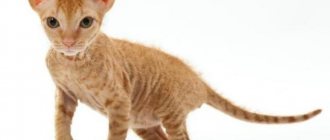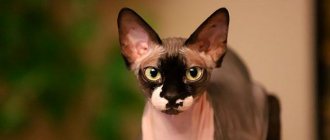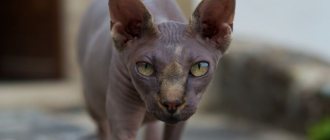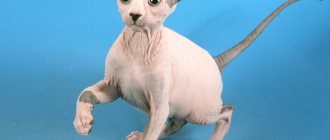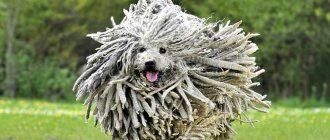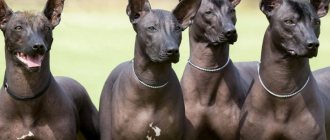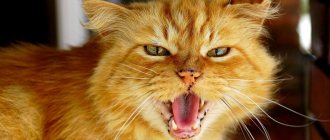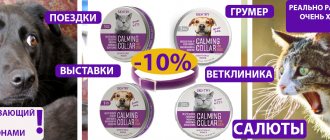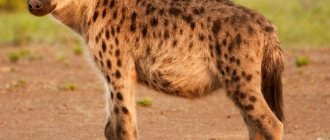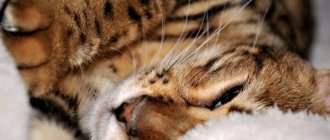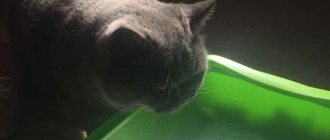Cats without hair are no longer considered a novelty, and it is no longer possible to surprise with them. Modern breeds of such cats make many people smile and want to touch their skin and stroke them. The Sphynx Brush is a cat with little fur on its body - the hair is short and sparse, more like fluff.
Don Sphynx brush.
Varieties of the Don breed
Representatives of the Don breed are the most diverse in length and density of coat. It is also worth noting a breed peculiarity: in the cold months, hairless cats are covered with short and sparse fluff, and in the warm season they go bald again. There are three types of cats of the Don breed of wool type.
Velor Sphynx
The Don Sphynx of the velor variety has quite long, fleecy hair, which is clearly noticeable when stroking the animal’s body. Fur covers the body from birth, although visually a newborn kitten appears bald.
The furs are hard, puff up when you run your hand against their growth, then return to their original position. A sexually mature Don Sphynx loses a significant part of its fur. Most cats only have their head and limbs covered.
Brush sphinx
If you breed hairless animals, then the combination of dominant genes results in a non-viable litter. Therefore, the Don Sphynx of the Brush variety is the result of crossing hairless and woolly cats. But if you breed two representatives of the brush type, hairless cubs will be born.
A newborn brush kitten is covered with dense, curly hair, which remains or falls out in an adult cat. The external characteristics of the Sphinx Brush are unstable. Representatives of the species are either naked or covered with fur, depending on climatic conditions, diet, and changes in hormonal levels.
The brush variety is characterized by autumn shedding. There are vibrissae, they are curved, which gives the animal a funny look. The coat may be uneven in length and thickness, which gives the Sphynx Brush a somewhat unkempt appearance.
Important! Brush sphinxes have no exhibition value and are not allowed into exhibitions. But they are often used for breeding.
Flock Sphynx
Newborn kittens of the flock variety visually appear bald, but in reality the body is covered with sparse hairs that fit tightly to the skin. To the touch, the flock kitten's body seems velvety.
As the animal grows, the velvet cover becomes thinner and gradually disappears.
Origin story
First of all, the difference between these two breeds lies in their origin.
Their homeland, as their name suggests, is Canada, or more precisely, the city of Ontario. It was in this second largest city in the country that the purposeful breeding of unusual hairless cats first began in the sixties of the last century.
It all started with a hairless kitten, born to an ordinary domestic cat, which, due to the lack of fur, was significantly different from its brothers and sisters. The amazing baby was named Prune. He turned out to be a carrier of the gene responsible for hairlessness.
But Prun was not destined to become the founder of a new unique breed of cats, since the breeders made one serious mistake. They crossed Prun exclusively with his sisters and nieces, and after several generations, the kittens, due to such close family ties, were born weak and often died a few days after birth.
Perhaps the world would never have known about the Canadian Sphynx if not for another hairless cat who was born in the American city of Wadena, and who was named Epidermis. American breeders turned out to be more cautious than Canadians, so they tried to find a cat to mate with Epidermis, with whom he would not be connected by blood ties.
There is a version that the Americans still managed to find distant descendants of Prun, who, together with Epidermis, were used for selection work to develop a new breed. This time, the breeders were lucky and were able to get several generations of completely healthy hairless kittens. The new breed was called the Canadian Sphynx, in honor of the first hairless cat born in Canada.
Don hairless cats are more than thirty years “younger” than their Canadian counterparts and appeared a thousand kilometers from America - in the Russian city of Rostov. Their story began with the bald cat Varvara, who was sheltered by a woman with a kind heart, Elena Kovaleva. Convinced that the pet’s hairlessness was due to some unknown disease, Elena even turned to veterinarians to cure her. But Varvara surprised her mistress by giving birth to babies as hairless as herself.
Russian breeders became interested in the unusual hairless kittens and wasted no time in starting selection work to breed them. The Russian sphinxes received their name in honor of the mighty deep river - the Don.
The difference between these two breeds is not only in their origin, but also in the fact that Canadian Hairless cats are today recognized by all international cat organizations, while the Don have received the status of only an experimental breed.
Dimensions and parameters
The Don Sphynx is a cat with a harmonious and graceful physique and a strong skeleton. With its physique and facial features, the Don pet resembles an alien creature.
Body size is average. Height at the withers is 25–30 cm. The male weighs 6–7 kg, the female – 4–5 kg.
Sphynx brushes are divided into three categories based on the thickness of their coat:
- Velor brush. Hairs up to 5 mm long. In an adult cat, the coat becomes flocked: hairs remain on the neck and body.
- Brush point. A newborn kitten has dense fur. After a year of life, the coat is discharged. Short and dense hair remains on the face and tail. The rest of the body is velor.
- Dense brush. The body is covered with dense wool, through which the skin does not show through.
The Sphynx brush can be any color. The most common are red, black, blue, lilac, white, gray, cream, chocolate, and tortoiseshell cats.
Hooded (rubber)
At birth, this type has no hair at all, and may also lack whiskers (whiskers, eyebrows and tactile hairs on the limbs). These kittens are often born with their eyes open, like human children. The color is further determined by the paw pads. The skin of naked kittens is thin, elastic, forming folds throughout the body. During the cold period, the entire body can become overgrown with sparse, fine hair.
Description of the breed and parameters of the Sphinx Brush
The breed standard for sphinxes is strict. Anatomical and external parameters are shown in the table.
| head | triangular, high cheekbones, narrowed downwards, noticeable brow ridges, flattened forehead, straight nose, prominent whisker pads |
| eyes | medium size, almond-shaped, iris of any possible color for a cat |
| ears | disproportionately large, widely spaced, slightly inclined forward, with a wide base and rounded ends |
| vibrissae | unequal length, curved |
| torso | strong, sinewy, elongated, dignified, harmoniously and gracefully built, with well-developed muscles, straight spine, wide croup |
| limbs | elongated, thin, graceful, oblong paws with long toes |
| tail | long, thin, with a rounded end, without strong bends |
Preventive measures
To minimize the risk of a hoarse cough in cats, you need to adhere to the following rules:
- promptly vaccinate the animal against infectious diseases;
- carry out regular treatments against helminths and skin parasites;
- brush the hair of representatives of long-haired breeds daily;
- periodically feed gels and pastes to remove hair from the stomach;
- prevent pets from hypothermia;
- strictly observe the rules of cat hygiene and ensure high-quality living conditions;
- Do not feed your cat raw river fish and tubular bones.
Average lifespan
With proper care, the Don Sphynx lives 13–15 years. Obesity significantly reduces life expectancy, which causes diseases of the joints, heart, blood vessels, and digestive organs.
In order for your pet to remain healthy and live a long time, it is necessary to regularly take it to the veterinarian for preventative checks. At 6 weeks of age, the kitten is vaccinated against distemper, calcivirosis and rhinotracheitis.
At the 8th week of life, the pet is given a vaccine against rabies, at the 12th - against leukemia, at the 13th - against chlamydia. A one-year-old kitten is revaccinated, then the vaccinations are repeated annually. Before vaccination, the pet is given tablets to prevent helminthiasis.
Nurseries
Don Sphynx velor, flock and hairless are often found in advertisements for sale, but it is worth purchasing a kitten from a registered nursery. There are several of these in Moscow and St. Petersburg:
- Sviatoslav;
- Stone;
- My Toys;
- De MariNika;
- Ramzes;
- Avatar;
- Of Newa Prestige;
- Okhta Style.
The nursery provides the buyer with a pedigree, champion achievements of the kitten’s parents, club membership, and a nursery registration certificate.
Character of the breed
The Don Sphynx is affectionate, gentle, requiring care and communication. This is a completely non-aggressive animal, but touchy and vulnerable. The Sphynx Brush needs the owner's attention and loves to sit on a person's lap. He can be obsessive when petting him, but quickly realizes that the owner is busy and cannot pay attention to him.
By temperament, the Don Brush pet is sanguine. He is sociable, friendly, inquisitive, non-conflict. If he is not busy with an exciting activity or game, he dozes off in a cozy place.
The Don Sphynx is a wonderful partner for children's games. He willingly participates in children's undertakings, is patient with pampering, and will not allow himself to show aggression towards the child. The Sphinx's attitude towards other domestic animals is loyal and friendly. The pet is ready to share a home with large non-aggressive dogs, and with decorative rodents, and with birds.
How to toilet train a Sphynx
Sphynxes are clean animals and are easily litter trained. If your pet ignores the toilet, it means he doesn’t like something. Try choosing a different tray or experiment with fillers. Do not use physical force or scold your pet during training.
Do not miss
- Do not miss
How to train a kitten to use a litter box in an apartment: step-by-step instructions
It is not recommended to use silica gel filler: the baby may accidentally swallow the “balls” and get poisoned. Life hack: before pouring the filler, place the bag on the tray - this way the plastic will not absorb the smell. During cleaning, collect the film and throw the granules into the trash.
Care and maintenance
There are no difficulties in caring for the Sphynx Brush. But care must be regular.
| eyes | The teardrops are cleaned daily with a lint-free cloth moistened with boiled water or chamomile infusion |
| ears | clean it twice a week with a cotton swab moistened with veterinary ear lotion, but you should not go deep into the ear with a cotton swab, so as not to injure the internal tissues |
| claws | cut with a nail clipper as they grow, the procedure is carried out with extreme caution so as not to touch living tissue with blood capillaries |
| teeth | Clean 2 times a week with a soft brush using veterinary paste. |
| body | bathing is carried out 2 times a month; to clean the delicate fur of the brush, use baby soap or pet shampoo with an antibacterial effect |
Reviews
All owners of such tailed animals are very happy with them, it is impossible not to fall in love with them; as a rule, such pets become loved by all family members, even if someone is initially put off by their appearance. Cats of this variety are disciplined, easy to train and raise, and love to be photographed.
They are loyal and love their owners, meeting them at the doorstep and following them around the house everywhere. They often sleep in bed with people, love to purr on their knees and sleep in the warmth of human hugs.
To read: Miniature hunting breed dwarf cocker spaniel: pet character traits
Some take in adult animals, and they still quickly adapt to the new environment. They love children and easily find a common language with other representatives of the animal world. They do not spoil wallpaper and furniture, especially if you accustom them to scratching posts from childhood. They always go to the toilet in the litter box. The only thing that can be a problem for busy people is daily wiping, but for those who are already used to it, caring for a cat is a pleasure.
Diet
The Donskoy pet must eat a lot, since its body, covered with light brush hair, actively gives off heat, and metabolism in the body proceeds at a high speed. But overfeeding is unacceptable, otherwise the animal will become obese.
You can feed your Sphynx with store-bought food of the premium, superpremium or holistic categories, and with natural products. In the second case, the diet includes:
- lean meat;
- sea fish;
- boiled eggs;
- cereal porridge;
- fermented milk products;
- vegetables.
Note! A kitten up to 3 months old should eat 5 times a day, a six-month-old kitten should eat 4 times, and an adult Sphynx should eat 3 times.
The Sphinx should not be treated to fatty meat, fried food, river fish, bones, smoked meats, pickles, sausages, sweets, bread products, or waste from the master's table.
pros
Many owners note the friendly and easy-going nature of Sphynx cats with fur. Cats of this breed have the following advantages:
- lack of aggression;
- high intelligence;
- learning ability;
- good harmony with other species of animals;
- pickiness in food;
- cleanliness.
In addition, Sphynx cats with fur are considered healing cats. They have increased heat exchange, and the surface of the hair always remains hot. These animals can be used as living heating pads. They are extremely affectionate and love to cuddle up to the human body.
Health
The Donskoy pet Brush is distinguished by good health. But due to his short hair, he is susceptible to colds. Therefore, a brush cat should not be kept in a draft or walked in cool weather.
Representatives of the Don breed have a strong heart, but dermatological pathologies can arise due to illiterate care and an allergic reaction.
The following breed defects are characteristic of sphinxes:
- microphthalmia (abnormally small size of the eyeball);
- shortened lower jaw;
- turning of the eyelids;
- deformation of the caudal vertebrae;
- hyperplasia (proliferation) of the mammary glands;
- vasculitis (cutaneous form).
Attention! A genetic anomaly characteristic of Sphynx cats is the underdevelopment of the thymus gland, which is responsible for the functioning of the immune system. With this pathology, the kitten dies at an early age.
Price
Sphinx Brush is a case where price determines quality. The price cannot be low - focus on the price tag of $300. A high price will mean that the kitten has a pedigree. We also advise you to purchase babies only from trusted breeders, so the likelihood of buying a healthy kitten is much higher.
Brush Sphynxes are fragile creatures that require regular care and attention, so before purchasing a kitten, it is important to correctly calculate your strength to provide it with a decent life. Otherwise, there is a high risk of developing diseases that can significantly shorten the pet’s life.
Did you like the article?
Choosing a kitten
You should buy a kitten when it is 3 months old. By this age, he becomes strong and independent, knows how to use a scratching post and a tray.
Buy a pet from a nursery or at an exhibition. The seller must provide the buyer with a pedigree and a veterinary passport with entered vaccination data.
A healthy kitten is selected based on the following characteristics:
- friendly, fearless, non-aggressive, lively, inquisitive behavior;
- a well-fed, harmoniously built body;
- clean eyes, ears, nose, anal area;
- elastic abdomen without inflammation and knots;
- soft brush wool that evenly covers the entire body;
- absence of bald spots, traces of parasitic and dermatological diseases.
Disqualifying faults
A number of breed defects result in a cat being disqualified from breeding. Such deficiencies include underbite of more than 2 mm and entropion of the eyelids. Other defects simply reduce the show score. Such shortcomings include the following deviations from standards:
- small ears;
- low set ears;
- slightly weak body;
- shortening of the body;
- undershot less than 2 mm;
- round eye shape;
- short head;
- round head shape;
- narrow muzzle;
- short tail;
- tail curled up.
Kittens that differ from the breed standard are sold cheaper. Because of this, they are in particular demand, since when getting a cat with which it is not planned to participate in exhibitions, the future owner, as a rule, tries not to overpay.
If a breeder offers a kitten with a pronounced defect and claims that with age the defect will go away and the pet will perfectly meet the standard, then you should not believe this - this does not happen.
